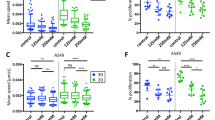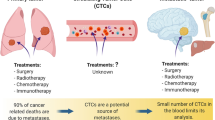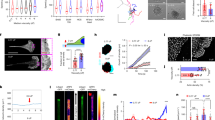Abstract
The mechanical characteristics presented in cancer microenvironment are known to have pivotal roles in cancer metastasis, which accounts for the leading cause of death from malignant tumors. However, while a uniformly distributed high interstitial fluid pressure (IFP) is a common feature in solid tumors, the effects of high IFP on the motility and invasiveness of cancer cells remain obscure. Using cell-culture devices that simulated increased IFP conditions by applying hydrostatic pressure (HP) ranging from 0 to 20 mm Hg to the cells, we found that the elevated HPs increased the migration speeds, invasiveness, cell volume, filopodial number and aquaporin-1 (AQP1), Snail and vinculin expression levels, as well as phosphorylation of caveolin-1 and extracellular signal–regulated kinase1/2 (ERK1/2), in the lung cancer cells CL1-5 and A549. The increases of migration speed and cell volume correlated temporally with the increase of AQP1 expression. The elevated HP-induced migration acceleration was hindered by AQP1 knockdown using small interfering RNA (siRNA) transfection. Inhibition of ERK1/2 phosphorylation using the mitogen-activated protein kinase kinase inhibitor PD98059 abrogated the elevated HP-induced AQP1 upregulation and migration acceleration in the cancer cells. Caveolin-1 knockdown by siRNA transfection attenuated the HP-induced, ERK1/2-depedent AQP1 upregulation and migration acceleration. Further biochemical studies revealed that the caveolin-1 activation-driven ERK1/2 signaling is mediated by Akt1/2 phosphorylation. By contrast, the elevated HPs had negligible effects on the migration speed and volume of normal bronchial epithelial cells. These results disclose a novel mechanism relating high IFP to the invasiveness of cancer cells and highlight potential targets to impede cancer spreading.
This is a preview of subscription content, access via your institution
Access options
Subscribe to this journal
Receive 50 print issues and online access
$259.00 per year
only $5.18 per issue
Buy this article
- Purchase on Springer Link
- Instant access to full article PDF
Prices may be subject to local taxes which are calculated during checkout








Similar content being viewed by others
References
Gupta GP, Massague J . Cancer metastasis: building a framework. Cell 2006; 127: 679–695.
Jain RK . Barriers to drug delivery in solid tumors. Sci Am 1994; 271: 58–65.
Curti BD, Urba WJ, Alvord WG, Janik JE, Smith JW 2nd, Madara K et al. Interstitial pressure of subcutaneous nodules in melanoma and lymphoma patients: changes during treatment. Cancer Res 1993; 53: 2204–2207.
Boucher Y, Baxter LT, Jain RK . Interstitial pressure gradients in tissue-isolated and subcutaneous tumors: implications for therapy. Cancer Res 1990; 50: 4478–4484.
Eikenes L, Bruland OS, Brekken C, Davies CDL . Collagenase increases the transcapillary pressure gradient and improves the uptake and distribution of monoclonal antibodies in human osteosarcoma xenografts. Cancer Res 2004; 64: 4768–4773.
Rubin K, Sjoquist M, Gustafsson AM, Isaksson B, Salvessen G, Reed RK . Lowering of tumoral interstitial fluid pressure by prostaglandin E-1 is paralleled by an increased uptake of Cr-51-EDTA. Int J Cancer 2000; 86: 636–643.
Milosevic M, Fyles A, Hedley D, Pintilie M, Levin W, Manchul L et al. Interstitial fluid pressure predicts survival in patients with cervix cancer independent of clinical prognostic factors and tumor oxygen measurements. Cancer Res 2001; 61: 6400–6405.
Fyles A, Milosevic M, Pintilie M, Syed A, Levin W, Manchul L et al. Long-term performance of interstial fluid pressure and hypoxia as prognostic factors in cervix cancer. Radiother Oncol 2006; 80: 132–137.
Rofstad EK, Tunheim SH, Mathiesen B, Graff BA, Halsor EF, Nilsen K et al. Pulmonary and lymph node metastasis is associated with primary tumor interstitial fluid pressure in human melanoma xenografts. Cancer Res 2002; 62: 661–664.
Saadoun S, Papadopoulos MC, Hara-Chikuma M, Verkman AS . Impairment of angiogenesis and cell migration by targeted aquaporin-1 gene disruption. Nature 2005; 434: 786–792.
Papadopoulos MC, Saadoun S, Verkman AS . Aquaporins and cell migration. Pflugers Arch 2008; 456: 693–700.
Loitto VM, Forslund T, Sundqvist T, Magnusson KE, Gustafsson M . Neutrophil leukocyte motility requires directed water influx. J Leukoc Biol 2002; 71: 212–222.
Stroka KM, Jiang H, Chen SH, Tong Z, Wirtz D, Sun SX et al. Water permeation drives tumor cell migration in confined microenvironments. Cell 2014; 157: 611–623.
Hu J, Verkman AS . Increased migration and metastatic potential of tumor cells expressing aquaporin water channels. FASEB J 2006; 20: 1228–1236.
Ribatti D, Ranieri G, Annese T, Nico B . Aquaporins in cancer. Biochim Biophys Acta 2014; 1840: 1550–1553.
Hoque MO, Soria JC, Woo JH, Lee T, Lee J, Jang SJ et al. Aquaporin 1 is overexpressed in lung cancer and stimulates NIH-3T3 cell proliferation and anchorage-independent growth. Am J Pathol 2006; 168: 1345–1353.
Sinha B, Koster D, Ruez R, Gonnord P, Bastiani M, Abankwa D et al. Cells respond to mechanical stress by rapid disassembly of caveolae. Cell 2011; 144: 402–413.
Parton RG, del Pozo MA . Caveolae as plasma membrane sensors, protectors and organizers. Nat Rev Mol Cell Biol 2013; 14: 98–112.
Dubroca C, Loyer X, Retailleau K, Loirand G, Pacaud P, Feron O et al. RhoA activation and interaction with caveolin-1 are critical for pressure-induced myogenic tone in rat mesenteric resistance arteries. Cardiovasc Res 2007; 73: 190–197.
Zhang BF, Peng FF, Wu DC, Ingram AJ, Gao B, Krepinsky JC . Caveolin-1 phosphorylation is required for stretch-induced EGFR and Akt activation in mesangial cells. Cell Signal 2007; 19: 1690–1700.
Luo DX, Cheng JM, Xiong Y, Li JM, Xia CL, Xu CX et al. Static pressure drives proliferation of vascular smooth muscle cells via caveolin-1/ERK1/2 pathway. Biochem Biophys Res Commun 2010; 391: 1693–1697.
Gortazar AR, Martin-Millan M, Bravo B, Plotkin LI, Bellido T . Crosstalk between caveolin-1/extracellular signal-regulated kinase (ERK) and beta-catenin survival pathways in osteocyte mechanotransduction. J Biol Chem 2013; 288: 8168–8175.
Umenishi F, Schrier RW . Hypertonicity-induced aquaporin-1 (AQP1) expression is mediated by the activation of MAPK pathways and hypertonicity-responsive element in the AQP1 gene. J Biol Chem 2003; 278: 15765–15770.
Wang C-C, Lee K-L, Lee C-H . Wide-field optical nanoprofilometry using structured illumination. Opt Lett 2009; 34: 3538–3540.
Wang C-C, Kao Y-C, Chi P-Y, Huang C-W, Lin J-Y, Chou C-F et al. Asymmetric cancer-cell filopodium growth induced by electric-fields in a microfluidic culture chip. Lab Chip 2011; 11: 695–699.
Liou Y-R, Torng W, Kao Y-C, Sung K-B, Lee C-H, Kuo P-L . Substrate stiffness regulates filopodial activities in lung cancer cells. PLoS One 2014; 9: e89767.
Kovbasnjuk O, Mourtazina R, Baibakov B, Wang T, Elowsky C, Choti MA et al. The glycosphingolipid globotriaosylceramide in the metastatic transformation of colon cancer. Proc Natl Acad Sci USA 2005; 102: 19087–19092.
Machesky LM . Lamellipodia and filopodia in metastasis and invasion. FEBS Lett 2008; 582: 2102–2111.
Pan S-H, Chao Y-C, Hung P-F, Chen H-Y, Yang S-C, Chang Y-L et al. The ability of LCRMP-1 to promote cancer invasion by enhancing filopodia formation is antagonized by CRMP-1. J Clin Invest 2011; 121: 3189–3205.
Liao W-Y, Ho C-C, Hou H-H, Hsu T-H, Tsai M-F, Chen K-Y et al. Heparin cofactor II enhances cell motility and promotes metastasis in non-small-cell lung cancer. J Pathol 2015; 235: 50–64.
Ikenouchi J, Matsuda M, Furuse M, Tsukita S . Regulation of tight junctions during the epithelium-mesenchyme transition: direct repression of the gene expression of claudins/occludin by Snail. J Cell Sci 2003; 116: 1959–1967.
Barrallo-Gimeno A, Nieto MA . The Snail genes as inducers of cell movement and survival: implications in development and cancer. Development 2005; 132: 3151–3161.
Merikallio H, Turpeenniemi-Hujanen T, Pääkkö P, Mäkitaro R, Riitta K, Salo S et al. Snail promotes an invasive phenotype in lung carcinoma. Respir Res 2012; 13: 104.
Ji L, Lim J, Danuser G . Fluctuations of intracellular forces during cell protrusion. Nat Cell Biol 2008; 10: 1393–1400.
Rubashkin MG, Cassereau L, Bainer R, DuFort CC, Yui Y, Ou G et al. Force engages vinculin and promotes tumor progression by enhancing PI3K activation of phosphatidylinositol (3,4,5)-triphosphate. Cancer Res 2014; 74: 4597–4611.
Kelley LC, Hayes KE, Ammer AG, Martin KH, Weed SA . Cortactin phosphorylated by ERK1/2 localizes to sites of dynamic actin regulation and is required for carcinoma lamellipodia persistence. PLoS One 2010; 5: e13847.
MacGrath SM, Koleske AJ . Cortactin in cell migration and cancer at a glance. J Cell Sci 2012; 125: 1621–1626.
Leong HS, Robertson AE, Stoletov K, Leith SJ, Chin CA, Chien AE et al. Invadopodia are required for cancer cell extravasation and are a therapeutic target for metastasis. Cell Rep 2014; 8: 1558–1570.
Wirtz D, Konstantopoulos K, Searson PC . The physics of cancer: the role of physical interactions and mechanical forces in metastasis. Nat Rev Cancer 2011; 11: 512–522.
Rizzo V, Morton C, DePaola N, Schnitzer JE, Davies PF . Recruitment of endothelial caveolae into mechanotransduction pathways by flow conditioning in vitro. Am J Physiol Heart Circ Physiol 2003; 285: H1720–H1729.
Radel C, Rizzo V . Integrin mechanotransduction stimulates caveolin-1 phosphorylation and recruitment of Csk to mediate actin reorganization. Am J Physiol Heart Circ Physiol 2005; 288: H936–H945.
Joshi B, Strugnell SS, Goetz JG, Kojic LD, Cox ME, Griffith OL et al. Phosphorylated caveolin-1 regulates Rho/ROCK-dependent focal adhesion dynamics and tumor cell migration and invasion. Cancer Res 2008; 68: 8210–8220.
Stahlhut M, van Deurs B . Identification of filamin as a novel ligand for caveolin-1: evidence for the organization of caveolin-1-associated membrane domains by the actin cytoskeleton. Mol Biol Cell 2000; 11: 325–337.
Muriel O, Echarri A, Hellriegel C, Pavon DM, Beccari L, Del Pozo MA . Phosphorylated filamin A regulates actin-linked caveolae dynamics. J Cell Sci 2011; 124: 2763–2776.
Deschenes-Simard X, Kottakis F, Meloche S, Ferbeyre G . ERKs in cancer: friends or foes? Cancer Res 2014; 74: 412–419.
Adjei AA, Cohen RB, Franklin W, Morris C, Wilson D, Molina JR et al. Phase I pharmacokinetic and pharmacodynamic study of the oral, small-molecule mitogen-activated protein kinase kinase 1/2 inhibitor AZD6244 (ARRY-142886) in patients with advanced cancers. J Clin Oncol 2008; 26: 2139–2146.
Bekaii-Saab T, Phelps MA, Li X, Saji M, Goff L, Kauh JS et al. Multi-institutional phase II study of selumetinib in patients with metastatic biliary cancers. J Clin Oncol 2011; 29: 2357–2363.
Verkman AS, Anderson MO, Papadopoulos MC . Aquaporins: important but elusive drug targets. Nat Rev Drug Discov 2014; 13: 259–277.
Gomes LR, Vessoni AT, Menck CFM . Three-dimensional microenvironment confers enhanced sensitivity to doxorubicin by reducing p53-dependent induction of autophagy. Oncogene 2015; 34: 5329–5340.
Chu Y-W, Yang P-C, Yang S-C, Shyu Y-C, Hendrix MJC, Wu R et al. Selection of invasive and metastatic subpopulations from a human lung adenocarcinoma cell line. Am J Respir Cell Mol Biol 1997; 17: 353–360.
Arciszewski MB, Stefaniak M, Zacharko-Siembida A, Całka J . Aquaporin 1 water channel is expressed on submucosal but not myenteric neurons from the ovine duodenum. Ann Anat Anat Anz 2011; 193: 81–85.
Nicchia GP, Stigliano C, Sparaneo A, Rossi A, Frigeri A, Svelto M . Inhibition of aquaporin-1 dependent angiogenesis impairs tumour growth in a mouse model of melanoma. J Mol Med 2013; 91: 613–623.
Acknowledgements
This work was supported by the grants from the Taiwan Ministry of Science of Technology (Grant Nos. MOST 102-2221-E-002-066, 103-2320-B-002-004-MY3 and 103-2112-M-001-019-MY3).
Author information
Authors and Affiliations
Corresponding authors
Ethics declarations
Competing interests
The authors declare no conflict of interest.
Additional information
Supplementary Information accompanies this paper on the Oncogene website
Rights and permissions
About this article
Cite this article
Kao, YC., Jheng, JR., Pan, HJ. et al. Elevated hydrostatic pressure enhances the motility and enlarges the size of the lung cancer cells through aquaporin upregulation mediated by caveolin-1 and ERK1/2 signaling. Oncogene 36, 863–874 (2017). https://doi.org/10.1038/onc.2016.255
Received:
Revised:
Accepted:
Published:
Issue Date:
DOI: https://doi.org/10.1038/onc.2016.255
This article is cited by
-
The impact of tumor microenvironment: unraveling the role of physical cues in breast cancer progression
Cancer and Metastasis Reviews (2024)
-
Biophysics in tumor growth and progression: from single mechano-sensitive molecules to mechanomedicine
Oncogene (2023)
-
Aquaporin-mediated dysregulation of cell migration in disease states
Cellular and Molecular Life Sciences (2023)
-
Evaluation of cytotoxic T lymphocyte-mediated anticancer response against tumor interstitium-simulating physical barriers
Scientific Reports (2020)
-
Inhaled gold nanoparticles cause cerebral edema and upregulate endothelial aquaporin 1 expression, involving caveolin 1 dependent repression of extracellular regulated protein kinase activity
Particle and Fibre Toxicology (2019)



